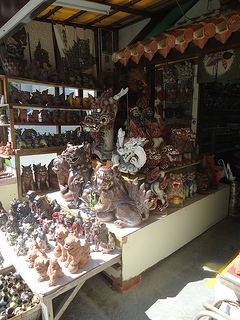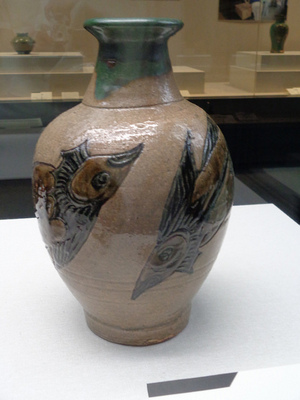Difference between revisions of "Tsuboya pottery"
| Line 9: | Line 9: | ||
The [[Aragaki house]] and ''agari-nu-gama'' ("eastern kiln") pottery kilns in the district have been designated [[Important Cultural Properties]] at the national level, while the district's ''fee-nu-kama'' ("southern kiln"), the only still-active ''arayachi'' kiln in the district, is a prefectural important cultural property. | The [[Aragaki house]] and ''agari-nu-gama'' ("eastern kiln") pottery kilns in the district have been designated [[Important Cultural Properties]] at the national level, while the district's ''fee-nu-kama'' ("southern kiln"), the only still-active ''arayachi'' kiln in the district, is a prefectural important cultural property. | ||
| − | The district has two communal springs. The ''agari nu kaa'' 東ヌカー, at the eastern end of Yachimun-dôri, was the earlier well to be dug; it's said to be over 300 years old. Up until WWII, it was a vital source of drinking water for the community. Since the spread of modern plumbing, the spring is less-used for that purpose but remains a site of worship and sacred reverence. | + | The district has two communal springs. The ''agari nu kaa'' (東ヌカー, "eastern spring"), at the eastern end of Yachimun-dôri, was the earlier well to be dug; it's said to be over 300 years old. Up until WWII, it was a vital source of drinking water for the community. Since the spread of modern plumbing, the spring is less-used for that purpose but remains a site of worship and sacred reverence. Additional springs included the ''ufukaa'' (大カー, "large spring") and the ''shimu nu kaa'' (下ヌカー, "lower spring"), which were used both as sites of worship and as sources for water for drinking, washing, and other everyday purposes. |
{{stub}} | {{stub}} | ||
| Line 15: | Line 15: | ||
==References== | ==References== | ||
*Gallery labels, Okinawa Prefectural Museum.; Gallery labels, "The Tsuboya-yaki region" and "Okinawan pottery," Gallery 4: Minzoku, National Museum of Japanese History. | *Gallery labels, Okinawa Prefectural Museum.; Gallery labels, "The Tsuboya-yaki region" and "Okinawan pottery," Gallery 4: Minzoku, National Museum of Japanese History. | ||
| − | *Plaques on-site in Tsuboya.[https://www.flickr.com/photos/toranosuke/26127673288/sizes/h/][https://www.flickr.com/photos/toranosuke/49737462227/sizes/l/] | + | *Plaques on-site in Tsuboya.[https://www.flickr.com/photos/toranosuke/26127673288/sizes/h/][https://www.flickr.com/photos/toranosuke/49737462227/sizes/l/][https://www.flickr.com/photos/toranosuke/49736583443/in/photostream/] |
[[Category:Ryukyu]] | [[Category:Ryukyu]] | ||
[[Category:Art and Architecture]] | [[Category:Art and Architecture]] | ||
Revision as of 07:23, 9 April 2020


- Japanese: 壺屋焼 (Tsuboya yaki)
The Tsuboya neighborhood of Naha is the center of Ryukyuan pottery production. It was established as such in 1682, when King Shô Tei ordered the kingdom's potters to relocate to the area, and it remains the center of Ryukyuan pottery today. Located within the Mawashi area of the city, the district is a major tourist site today, and includes a number of kilns and pottery shops organized around Yachimun-dôri ("pottery street"), as well as a Tsuboya Pottery Museum.
Following the formation of Tsuboya as a pottery district, a distinctive Tsuboya style emerged out of the interactions between potters from across the kingdom now brought together in this district. Up until the Meiji period, Tsuboya remained a center of production of relatively simple arayachi (荒焼, "rough wares"), or unglazed ceramics. It was only in the Taishô period that, seeing the great popularity of Arita wares in the mainland Japanese market and seeking to expand their market share, the Tsuboya potters began producing jôyachi (上焼, "completed wares"), that is, glazed ceramics, with elaborate designs of fish, dragons, and the like. Kinjô Jirô, Kobashigawa Eishô, and Aragaki Eisaburô, known as the "Three [Potters] of Tsuboya" (Tsuboya no sannin otoko), were particularly influential in the development of this style, prominently incorporating these motifs. Beginning in the 1960s-1970s, many potters moved elsewhere in the prefecture, but Tsuboya remains prominent and vibrantly active. As late as the early 20th century, there were as many as ten traditional-style arayachi kilns active in the district.
The Aragaki house and agari-nu-gama ("eastern kiln") pottery kilns in the district have been designated Important Cultural Properties at the national level, while the district's fee-nu-kama ("southern kiln"), the only still-active arayachi kiln in the district, is a prefectural important cultural property.
The district has two communal springs. The agari nu kaa (東ヌカー, "eastern spring"), at the eastern end of Yachimun-dôri, was the earlier well to be dug; it's said to be over 300 years old. Up until WWII, it was a vital source of drinking water for the community. Since the spread of modern plumbing, the spring is less-used for that purpose but remains a site of worship and sacred reverence. Additional springs included the ufukaa (大カー, "large spring") and the shimu nu kaa (下ヌカー, "lower spring"), which were used both as sites of worship and as sources for water for drinking, washing, and other everyday purposes.